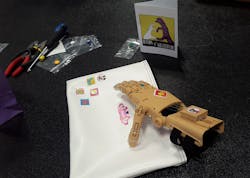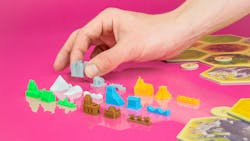Everything is moving at a rapid pace. Online trends occur over the course of weeks: content, games, and other digital products that were popular yesterday appear and disappear with equal speed. As product development in the physical world tries to keep up, development and manufacturing processes reveal a jarring mismatch of pace.
With physical goods, production can take months to ramp up, leaving manufacturers and brands scrambling to find solutions to bring physical products to market fast enough to stay relevant to contemporary trends and technology.
To keep up, product development for physical goods is entering a new era. Digital manufacturing can captivate the growing expectations of today’s customers at lightning speeds by meeting expectations for personalization, introducing novelty, taking advantage of economies of small, and getting products to market faster.
Meeting Expectations for Personalization
Around 250 years ago, the first industrial revolution changed our relationships with the objects that are a part of our daily lives. We shifted from artisanal objects with personal stories to disposable objects bought on the go.
The emergence of digital products has reintroduced the concept of personalization to the masses. We interact with digital products that remember what we watched and liked, and that infer preferences we didn’t even know we had. As the amount and accessibility of information and content has grown quickly over the past several decades, this type of personalization has gone from being a convenience to a necessity.
Making low-volume custom parts is possible with digital manufacturing due to the elimination of tooling.
Hyper-personalized recommendations for music, movies, games, and other digital products and services have become expected. For example, Netflix doesn’t show you every movie in existence when you log in, but it does make personalized recommendations based on other movies you’ve watched and specific interests relevant to your profile. Netflix even personalizes the thumbnails for movies and shows with images that will best resonate with you. As this has become the norm, consumers are demanding it in other (physical) product categories as well.
These days, personalization for physical goods needs to move beyond simple gimmicks such as embroidering someone’s initials on their backpack. Top-tier tech firms have trained consumers to expect products that magically understand their desires.
With digital manufacturing, you can make products that are unique to an individual. When consumers can use a digital interface to recombine physical objects with different colors, graphics, and text, it gives the objects meaning and story.
Making Something Novel
You can make something feel personal without creating custom products on an individual basis. Our brains flood with dopamine whenever we encounter something new or novel. In fact, they’re hardwired for it. Seeing something new or unusual is like unlocking an achievement on a psychological level. Novel products might be creative and unexpected recombinations of pop-cultural icons like home state candles, mason jar cookie cutters, or animal showerheads. They evoke an element of surprise, excitement, and an enthusiasm to pass along the secret.
Zooheads is a brand of novelty showerheads that demonstrate the ability to manufacture custom complex quick parts with digital manufacturing (powered by Fulfilled by Voodoo).
Digital manufacturing processes like 3D printing enable creators to take risks developing and producing novel products without large capital investments. By being able to put products in the marketplace and test their performance and audience, they can continually improve and develop while proving the products’ viability.
Taking Advantage of the Economies of Small
Historically, creating novel products for small niches would have had a high cost and low potential for reward. Today, the costs are much lower and the potential reward is much higher. Not only do creators have access to full featured ecommerce platforms like Shopify and Squarespace, but they have access to insights about their customers and can learn how to get in touch with them.
At an event, Enable allowed attendees to assemble and decorate a prosthetic hand. These hands were printed and donated by Voodoo Manufacturing in Brooklyn, N.Y.
To add to the equation, digital manufacturing processes further reduce the barrier to entry by making it possible to launch businesses for significantly less capital. These capital-light methods create unlimited potential for businesses based on personalized products that could not exist before. Manufacturing custom robotic prostheses has only recently become economically viable due to on-demand digital manufacturing, and they radically improve the daily lives of the people who use them.
Getting to Market Faster
Products have a shorter shelf life than they used to. Retailers and brands have to capture value in small moments of opportunity. Riding these trend waves means being agile and flexible enough to respond to the speed of change, reaching customers directly and immediately. It means ramping down on a dying idea as fast as ramping up on a growing one.
With easy-to-produce custom parts, board games can be more engaging and faster to produce for beta testing, or to fulfill pre-orders.
Retailers can gain market validation before jumping into production through methods like crowdfunding. Kickstarter and Indiegogo are examples of this presale trend. As time goes on, these methods of presale are becoming more sophisticated. To speed up development, retailers like L.A.-based custom apparel company Frilly even sell products before they exist by posting renderings (a photo-realistic image of a 2D or 3D model) online. For customers, there might be little difference between those early rendered images and the end-product they receive later on.
Manufacture Your Next Idea
Have an idea you're thinking about producing? Look for companies that make it easy to start and scale your business’ products online. By dramatically decreasing the barrier to entry, entrepreneurs of any experience level can manufacture and scale the production of physical products, which means that almost anyone can become the next Yves Behar.
Sources
“Using 3D Printing to Manufacture Custom Prosthetics,” Formlabs, 5 Jan. 2017.
Boudet, Julien, et al. “What Shoppers Really Want from Personalized Marketing,” McKinsey & Company, Oct. 2017.
Chandrashekar, Ashok, Fernando Amat, Justin Basilico, and Tony Jebara. “Artwork Personalization on Netflix,” Netflix Technology Blog, Dec. 7 2017.
Desjardins, Jeff. “Here’s Why Some Things Go Viral on the Internet.” Business Insider, Business Insider, 13 Feb. 2018.
Leanne Luce is product manager at Voodoo Manufacturing.





